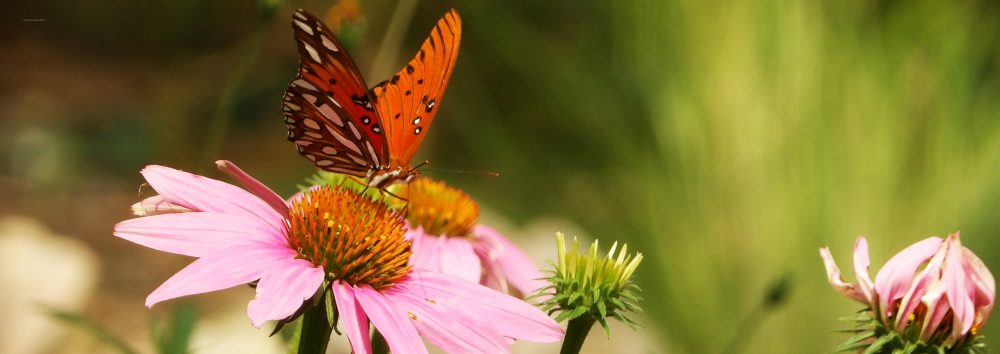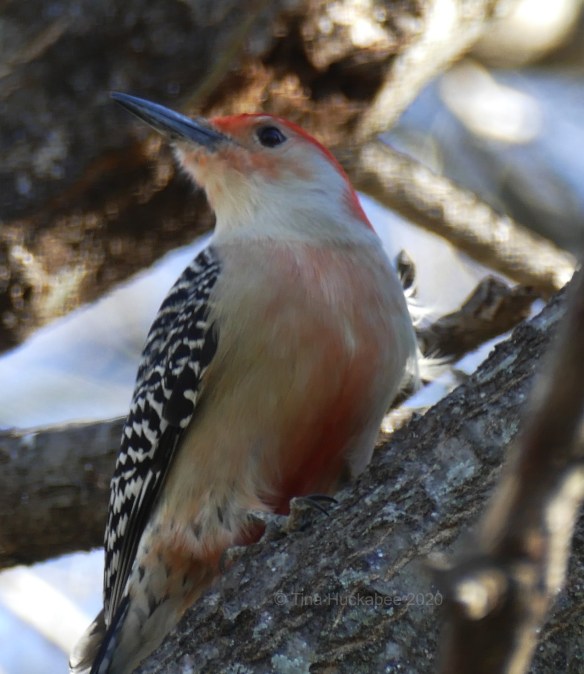Virginia is for Lovers is a long-time advertising slogan used to appeal to tourists interested in visiting Virginia and it’s apparently been a successful one. My riff on that slogan is February is for Wildlife Lovers in celebration of Wildlife Wednesday during this month where love and pairdom is paramount: a month of hearts and chocolates–and the birds and the bees–though for our purposes here, it’s the birds and the butterflies.
February is the month when human couples send flowers, share candy and/or make reservations at absurdly expensive and noisy restaurants. But some of my backyard birds are also busy in the art of love, or at least, in the art of settling down to the business of wooing, mating, and preparing for a family of winged things.
I typically see either the male or the female Red-bellied Woodpecker, Melanerpes carolinus, but I rarely see both partners on the same day. A couple of weekends ago, that paradigm changed, the female visiting first, in the tree.

It’s not a classically well-framed shot, but I love the stink-eye that she looks like she’s giving me. Red-bellied eye-rolling is about to commence!
After moving up along a main branch of my Red oak tree, she fluttered down to the black-oiled sunflower feeder for a quick snack. The female Red-bellies have little-to-no blush of red on their bellies and their splash of head red starts toward the back of their heads, extending down the nape of their necks.
A short while later, a handsome woodpecker chap visited the same tree and feeder.
With more red on his face, head, and belly, he’s a brightly patterned catch. I assume these two comprise the same couple who raised two clutches of junior woodpeckers last year. Red-bellied woodpeckers are monogamous and each share in nest building and chick raising. The males choose the nesting site, starting the pecking work on the hole; if the female accepts the offer and the site, she and her partner finish the construction together: the couple that builds together, stays together! Red-bellies are known to use the same tree for their nests, but build a new nesting hole for each new set of eggs.
At about the time that the Red-bellied couple visited, I enjoyed a similar sighting of both a female, then male Downy Woodpecker, Dryobates pubescens, again on the same day. The female has no red on her cute little head, but she’s adorned in snazzy black and white on her head, wings and back, with a lovely white tummy.
The male Downy has a dab of red atop his head, accompanied by similar-to-his mate black and white patterned feathers. Like the Red-bellies, the Downies are monogamous and both partners parent offspring. Last spring I enjoyed the privilege of watching Daddy Downy teach his little one how to flit from tree-to-feeder, then back again. Daddy birds rock!
I look forward to a new set of woodpecker kids in the neighborhood. The Red-bellied Woodpeckers nested in my neighbor’s tree–the one that my SIL now owns–and I’m certain that my SIL will enjoy watching these charmers as they build the nesting hole(s) and once again, become parents.
I don’t know where the Downy Woodpeckers nest. They fly in a northwesterly direction from my back garden, but I don’t know what tree, or trees, they’ve chosen to secure their little ones in past breeding seasons.
More pairing is underway with the mating of Gulf Fritillary butterflies, Agraulis vanillae. Butterfly wooing is quieter than bird wooing and mostly involves undulating flight patterns between the partners, who then rest somewhere as they seal the deal.
Due to our mild winter, there are active butterflies and not only Gulf Fritillaries, though they’re clearly in breeding mode with egg laying to follow. While I’d like to have some hard freezes (this month–NOT in March!), I haven’t at all objected to butterflies during this typically drab time of year. There are still some flowers for nectaring and my passion vine–the nursery for Gulf Fritillary caterpillars–is green and able to provide sustenance for the larvae, given that a hard freeze hasn’t yet killed it to the ground.
The breeding season for birds, butterflies, bees–and heck, everything else–is about to begin. It’s a time that gardeners can provide food, in the form of seeds and fruits, and with diverse choices of plants, as well as water and cover. If your garden is welcoming to wildlife, you can sit back and observe remarkable events in your garden: you’ll enjoy watching the wildlife lovers and their offspring and you’ll become a wildlife lover.
Please leave a link to your post when you comment here and happy wildlife gardening!








Boy oh boy do I love woodpeckers- how adorable are they?!
LikeLike
They are VERY adorable!
LikeLiked by 1 person
Here’s some proof that “everything else” is interested in a little love. This one’s not blog-quality, but it’s certainly proof that even the hoverflies are celebrating spring.
As for the birdies, I went to Wild Birds Unlimited a week ago and picked up some finch mix and dried mealworms. Now, I have pairs of house finches, chickadees, cardinals, doves, and house wrens visiting. I’ve had bluejays and mockingbirds stop by, too, but I’m not sure if they’re mated or pairs of competitors. There’s so much fussing it could be either!
And I just had something new land on the railing. It looks like the female house finch as far as color, but it’s about twice the size. It didn’t stay, but it looked things over for a good while. I’m going to add some hulled white millet to the mix for the ground feeders, and that should do it. I still haven’t had anything try out the mesh peanut feeder, but that may come. I’m pretty sure there aren’t any woodpeckers around here, but we’ll see.
LikeLiked by 1 person
That’s quite a photo, Linda. Hoverlove, indeed! 🙂
You know, I’ve never had much luck with either meal worms or finch mix–they just wouldn’t eat it. Not sure why, but my backyard birds love the peanuts, suet, and black-oiled sunflower seeds, so I stick with that. And you’re right–all that bird noise is either wooing or fighting to woo. Ah, love.
Could your new bird be a female Red-winged Blackbird? https://www.allaboutbirds.org/guide/Red-winged_Blackbird/id
LikeLiked by 1 person
I don’t think so, since I’ve never seen a single red-winged blackbird, meadowlark, flicker, etc. in the neighborhood. I wondered if it might have been a warbler of some sort. I tried Merlin, but apparently I didn’t get a good enough look to find a match on that site. I’ll have to just keep looking. There are warblers around, so it’s a possibility.
LikeLike
“NOT March” indeed!
Speaking of awesome daddies, there’s one called the Lily Trotter or African Jacana that I saw in a Nat Geo special on Botswana’s Okavango delta that blew my mind.
LikeLike
I’ll look that up–ty!!
LikeLike
I was so excited to see that little Downy Woodpecker in my garden (thanks for the ID correction by the way) a few weeks back, I can only imagine how exciting it would be to have two COUPLES in yours. Wow, that’s very cool!
LikeLike
Until I started offering peanuts, the only time I saw the Down Woodpeckers was in the winter, high up in the trees, moving fast! As for the Red-bellies, they like the sunflower seeds, so they would come to that feeder. Now, with peanuts, sunflower seeds, and trees–it’s a woodpecker fest!!
LikeLiked by 1 person
I would totally try that if it weren’t for our urban rat problem which ballooned a few years ago. I’m only putting out suet feeders and hummingbird feeders this year. I know we can never get rid of them completely, but I wish I had more space, so I could put the feeders far, far away from the house.
LikeLike
Hello. I love following your posts! This one is my favorite. I just started setting up bird feeders around my home. What birdseed recommendations can you give me? Thanks.
________________________________
LikeLike
Thanks, Katherine! I only feed three (sort of, four) items: year-round, it’s black-oiled sunflower seeds, shelled and unshelled peanuts. In our cool season, commercially made suet. You can make your own suet, but it requires cooking with lard, which I don’t use; there are lots of recipes out there, but if you go that route, try to use a bird site (Audubon, Cornell). I know lots of people who put out mixes, I’ve just never attracted more than White-winged Doves and House Sparrows with the mixes, so I avoid them. We have plenty of doves and House Sparrows. Good luck with your bird watching–it’s fun!
LikeLike
Yes, it is that time of year and all the birds are making a lot of noise. Your photos really caught that red belly.
LikeLike
Thanks–I love that shot!
LikeLiked by 1 person
How sweet! I haven’t seen woodpeckers in a while. I love to watch them walk upside down on a large limb.
Our nesting squirrel is back along with a few other sightings. Thanks for hosting!
https://rockoakdeer.blogspot.com/2020/02/wildlife-wednesday-february-2020.html?showComment=1580997929122#c4385784793780578757
LikeLike
Woodpeckers are fun to watch as they maneuver up and down a tree.
LikeLike
The Red-Bellied and Downey Woodpeckers frequent my feeder as well. Not near as many birds here as last winter or the year before. I really like watching the Nuthatch, too. Very comical. Thanks for sharing!
LikeLike
You’re welcome, Rooster. Oh, I’d love to see a Nuthatch; for me, it’s only been in photos.
LikeLiked by 1 person
These are really nice pics of the woodpeckers. And the gulfs too. I had the good fortune to grab some pics of gulfs mating about 5 years ago. It was most interesting. I had no idea…
LikeLike
Thanks! Well, all those butterflies have to come from somewhere…:)
LikeLiked by 1 person
I’m awaiting the mating season to begin when the males rat-a-tat-tat on my gutters to let everyone know…”hey, I got this area over here, no need to apply.”
LikeLike
Haha. Yes, they do seem to get the word out, one way or another, as to who owns what territory!
LikeLike
I love woodpeckers, and those butterflies are wonderful. No butterflies here, but a decent number of woodpeckers visiting the feeders.
LikeLike